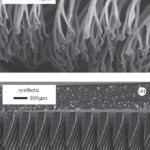Paper, Adhesive Nature and Structure of the Gecko Setae
Geckos are excellent at climbing smooth vertical surfaces and their toes are the key to this phenomenon. Research has found that there are a hundred thousand setae, made of Sub-division of beta-keratin, on the toes. These 30–130 µm long seta contain countless 0.2–0.5 µm spatula-shaped structures. Force sensor reveals that a seta operates by van der Waals forces. A unique macroscopic orientation and preloading of the seta increased attachment force 600-fold above that of frictional measurements of the material. Suitably orientated setae reduced the forces necessary to peel the toe by simply detaching above a critical angle with the substratum. Furthermore, gecko toes are well adapted to adhere to hydrophilic and hydrophobic surfaces.
Learn about our two Decals!
 Click here to find out more about our Fall Bioinspired Design Decal and our Spring Bioinspired Design in Action Decal – ALL MAJORS are welcome.
Click here to find out more about our Fall Bioinspired Design Decal and our Spring Bioinspired Design in Action Decal – ALL MAJORS are welcome.Berkeley BioDesign Community
 Click here to learn about the BioD: Bio-Inspired Design @ Berkeley student organization or here to signup for more info.
Click here to learn about the BioD: Bio-Inspired Design @ Berkeley student organization or here to signup for more info.Search
Student Login






I imagine that the neurological circuits underlying these processes are governed by both 2d spacing maps with their brains as…
to reduce the impact of car accidents, it may be possible to study the force diverting physics of cockroaches to…
you see this type of head-bobbing stability in many avian creatures related to pigeons like chickens. the head ability to…
not like they taught horses how to run! this is an example of convergent evolution where both sea creatures and…
The brain functions in a similar way with neuronal connections. our brains are able to utilize the multiplicity of connections…